|
FAQs about Sea Mats, Star Polyps Identification
1
Related Articles: Mat/Star Polyps, Blue, Pipe Organ Corals,
Related FAQs: Polyp/Clavulariid ID 2, Polyp/Clavulariid ID 3, Polyp/Clavulariid ID 4, & Polyps 1, Polyps 2, Polyps 3, Polyp Behavior, Polyp Compatibility, Polyp Selection, Polyp Systems, Polyp Feeding, Polyp Disease, Polyp Reproduction/Propagation,
|
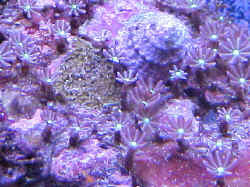
|
Need Help With ID of Aiptasia /
Featherduster... 7/18/06 Hello again
Crew! I'm in need of an ID of these clusters
of things that are popping up everywhere on my live
rock. If I brush my hand over them, the feather-like
tentacles retract into their tube. I've read through
the Aiptasia posts and still don't know if I'm on the right
track with this one. There are 3 pictures (jpeg) attached to show
you what I'm looking at. <Mmm, look more like some sort of
Zoanthid to me... though could be a type of colonial anemone>
Picture 1 entitled - "Unknown ID 1" Shows the
cluster on the live rock. Picture 2 entitled - "Unknown ID
2" Shows a different cluster magnified. Picture 3
entitled - "Is This Aiptasia" I'm 99.9%
sure this is the real deal? And again, another cluster
above the red circle. I just bought some Joe's Juice just in
case, but wanted to get a proper ID before I do anything. Thanks so
much for your help and an amazing website!!! Brett <I would
remove, scrub the infested rocks if you are overly concerned re the
spread, undesirability of this animal. I would not elect to use a
chemical poison with these. Do wear gloves, eye protection when
handling... Please read here: http://www.wetwebmedia.com/zoanthid.htm and the linked
files above.
Bob Fenner> |
|
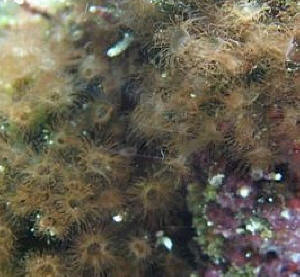 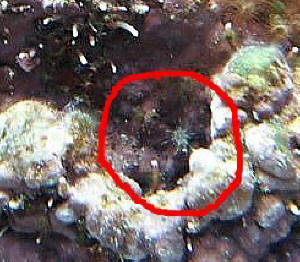
|
Re: Need Help With ID of Aiptasia /
Featherduster 7/18/06 Thanks, Bob! I've always
wanted to keep Zoanthids - now I know I can!!! Brett <Heeeee! Great!
BobF>
Re: Need Help With ID of Aiptasia /
Featherduster 7/17/06 One more thing about
these... Would you consider them a pest Zoanthid? <Mmm,
only if "too much", stinging, poisoning, taking up space you
would rather have used else wise> I would like to keep more
desirable types (layman - pretty) in the near future. Do you
think I would have a problem with them competing? <If nearby, yes,
definitely> I think I want to leave well enough alone now. Thanks
again, Brett <I would as well. Bob Fenner> Awesome, Thanks!
Brett
<Welcome. BobF>
Id these Polyps? 4/27/06 Hey WWF crew,
<Hey!> I purchased this rock of metallic green mushrooms at
my LFS. On it are a group of polyps, for which I have
not been able to get an ID. I was hoping you guys could
help me out. They appear to form a continuous mat, and are most
extended when lights are on. Each head is about
1/8" across, and the centers are a neon green color. <They
look to be some type of Zoanthid. Check WWM for info on
these.> Thanks and keep up the good work!
<Thanks, have a great one, Jen S.> |
|
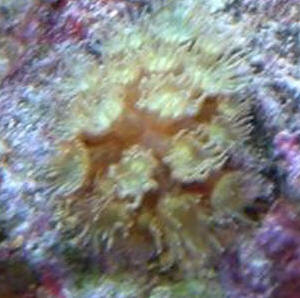 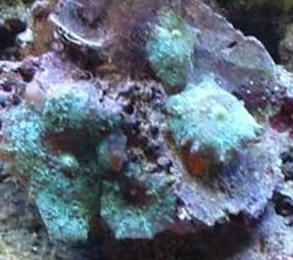
|
| Aiptasia... nope, "clove" polyps
4/10/06 [Original message below] Hi there! I am
attaching a photo of what I am pretty sure, from looking at your
site and others, is Aiptasia. I wrote a few weeks ago
when they had just appeared and were much smaller, but had no
access to a digital camera. Now, they have grown and
they look more like Aiptasia than baby dusters to
me. Please confirm if I am correct (though I really hope
they're harmless!). <Mmm, actually are a
stoloniferous animal... a Clavulariid... clove polyp type: http://wetwebmedia.com/clavulariids.htm> And, if I am
correct, do I need to take my duster out of the tank? <Mmm,
no... might need to be moved if this colony grows too close its
direction though.> They are all attached to this mat-like thing
wrapped around the duster's tube. I read that
scraping is a bad idea since they can regenerate if you cut
them. I've noticed my red-legged hermits munching on
them. When the crabs munch on them, does regeneration
result? <Possibly... though these colonies can be invasive on
their own> Finally, is it safe to use the Kalkwasser method when
they are on a feather duster? <Mmm... not on the animal/colony
itself, no> Thank you also for the Cyano info. What
you see in the picture is actually just about all we have
left. I bought the macroalgae 6-pack special from
Indo-Pacific and, although the "Tang Heaven" was eaten
within a couple of days, between the plants and siphoning, it
appears to be coming under control. <Ah good> I apologize for
not splitting these topics up the first time. I will
most certainly do that in the future though. Again,
thanks so much for all of your time and dedication. All
of you! Jen <I would enjoy this growth, animal... and keep it
isolated/small-enough by removing, cutting bits away, storing for a
few weeks after in isolation before returning to the main/display
tank. Bob Fenner> |
|
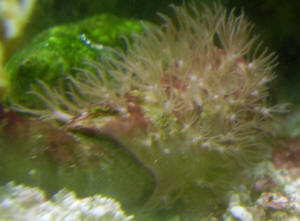
|
Coral ID 1/22/06 Hi Guys, <Hello> This
is a fragment of coral that is about 1cubic cm. It feels
yielding but not "soft" would you have any ideas of
it's ID and where the best location in the tank would
be. It has been on the sand, blowing around. <David,
picture a little fuzzy but I'm sure it is Aiptasia and not
coral. Best location for it would be the
toilet. You don't want these guys multiplying and
they do so quite fast. Read here. http://wetwebmedia.com/marine/inverts/cnidaria/anthozoa/aiptasia/aiptasia.htm
Thanks <You're welcome. James (Salty Dog)>
<<
David |
|
Re: Coral ID ... Aiptasia? - 01/23/2006 Hi James, Yeah,
sorry about the quality but I haven't the equipment for good
macro shots through glass. <Understand. My next
camera will definitely have macro
capabilities.> I'm not so sure that it's
Aiptasia, I have a few of those to compare it to. <Do search
Wet Web and others and I'm sure you will come up with pics to
compare to.> They are on a small piece of tan/brown tissue
with red/pink edge. This came as a scrap with live
rock and feels yielding to the touch. It floated
around on the substrate until the other day when I noticed the
polyps extended. I can clearly see that they, about 5
of varying sizes, are integral to the tissue fragment and not
attached to or in a crevice. The polyps are white,
have 8 "arms" ( Octocorallia??) <Mmmm, generally sea
fans, whips, pens, pansies etc.> and the largest are about 5mm
in diameter on a 5mm stalk with 5 mm long
tentacles. The tentacles are feathered on the edges
unlike the smooth Aiptasia. It is a new tank and I introduced the
live rock nearly two months ago and apart from some hermits and
snails for algae control there is nothing else in there and at
the moment there is something new every day. It is
amazing but also frustrating as identifying anything is so
impossible, pictures are usually crappy as most things are small,
elusive or nocturnal and you really need to have some basic idea
of an organisms id before trying to research it. Any
chance of you guys putting together a book dedicated to Live Rock
and its commonly emergent live forms?? I'd buy one
of those!! <Maybe Bob has one in the works, he may
input here regarding any book that may help you ID. If
you have a Barnes & Noble store in your area you may want to
check them out/peruse through their salt books.> Thanks
<You're welcome. James (Salty Dog)>
David
|
|
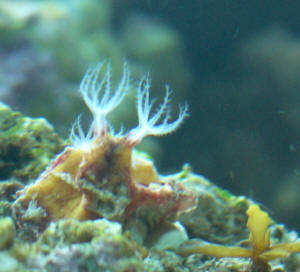
|
Star Polyps...Or Not - 12/18/05 By
"new", I mean the equivalent of babies. <<ok>> I
have had a green star polyp for maybe two years, and over this length
of time, it has spread to a small rock. I have moved the new
rock to decorate the rest of the tank, but it has never been green,
even when it was next to the original. It is brown, and the
tentacles are feathered, much like an organ pipe polyp, not smooth,
like the rest of the green star polyp. <<Tis a good chance these
"babies" are not star polyps at all.>> The original
rock is green, but there are times when some areas look like the new
rock. <<You may have two different species on one rock.>>
They seem to be like that after I have stirred up sand or
"dusted" the rocks. <<Maybe one "retreats",
allowing the other to show.>> But they always go back to green
and smooth. <<I can't say for sure what you are witnessing,
but it's not likely a physical transformation of the star
polyps.>> Or maybe the smooth green ones retract, exposing the
fuzzy brown, then open up again to hide them?
<<Aha! Now we're thinking along the same
lines.>> Anyways, why are they not green and smooth? <<A
different animal altogether me thinks.>> Is it because they are
young? <<Not in my experience.>> If so, how long until they
become green and smooth? They have been there for over a
year now. <<Like I said/you have deduced...not the same
critter.>> Thanks!! Rebecca <<Regards, EricR>>
Anemone? 7/25/05 Bob, <fine, BE that
way> Thanks for your quick response regarding the slugs that have
appeared in my tank. <He puts a ton of work into WWM, to the benefit
of all> I now have noticed something new on my LR. I'm attaching
a couple of photos for you to evaluate. Can you tell me if it's an
anemone? It's about 1.5" in diameter. Is it harmful? If so,
what's my recourse? <It's a pest 'Aiptasia' spp.
anemone. Do a search on WWM regarding Aiptasia> Best
regards, <To you, as well>
Terri
<M. Maddox>
| Candy Cane and Anthelia questions 8/1/04
Hello. I've spent many hours on your site and I must say
it's a great resource. <Great to hear!> I have a question
about a stony coral I have (candy cane). Last night I put a
flashlight on it and noticed that between the stony columns is
growing a yellow kind of "fuzz" or something. I am not
sure if it is a disease or algae or what. Otherwise the coral looks
healthy. Inflated during the day and tentacles out at night for
feeding. You can only see this stuff at night when it's
slightly deflated. I have attached an image so you can see what I
mean. We've had the coral for about 3 months now
with no problems. <This is nothing at all to worry
about. It is an encrusting sponge and a very common
occurrence between the branches of stony corals.> Several other
corals in the tank are soft ones. This is the only hard coral. The
tank is a 45 gal less than 6 months old, all readings are zero,
calcium is at 440 and pH is at 8.2 (we originally started it from
cycled water from our aquarist friend back then). I reduced the
picture and have a larger one if needed. On another note, the
anthelia has been struggling for days. I suspect it's the pH
but I am not sure since it's not excessively low. Would it help
to raise it and by how much? Also, there is a "life-form"
attached near by and I wonder if this is affecting it. At first I
thought it was a new colony of anthelia but now I wonder if it is
an unrelated different coral. A picture of this is attached as
well. Thank you for your help. Daphne <A pH of 8.2 is
perfect. What about alkalinity? IMO,
Alkalinity is probably the most important parameter to test
regularly in a reef tank. The coral in the picture is
actually Clavularia. There are several things growing
within and around it: Valonia (bubble algae), hair
algae, some Caulerpa and some kind of mushroom
anemone. Any or all of these things could be affecting
the Clavularia. I would try to move the mushroom, test
alkalinity and correct with a good quality buffer if necessary and
be sure that you have plenty of water movement. This is
a tough coral that should recover easily under good
conditions. Best Regards. AdamC.> |
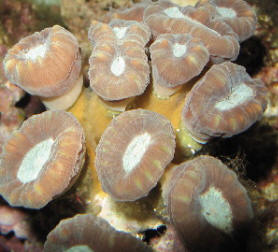 |
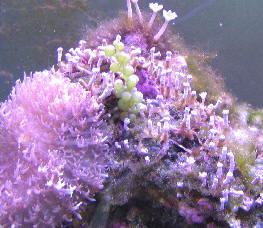 |
| Stony Coral and Anthelia part II 8/3/04 Hi,
thanks for your response. I forgot to mention that I am seeing tiny
pinkish white creatures swimming between the corals and LR with a
tail, kind of like a tiny tadpole. Are these pods or some kind of
shrimp? I assume they are a kind of shrimp.. are they good or bad?
<They sound like some kind of larvae. Probably
good. They don't do much, and probably won't
survive, but they are good food for your other critters.> As for
the "anthelia"- Clavularia and the mushroom thing, they
came encrusted on a piece of LR, I didn't actually purchase it.
I got rid of the Caulerpa and am working on getting rid of the
other algae. The "mushroom" looks securely attached to
the LR. Will I damage it if I pull it off? At night it shrinks to a
very small size and I wonder if that's the best time to remove
it from there. <The mushroom can easily be removed by working a
knife or screwdriver under the edge, gently working it to scrape
the mushroom off of the rock. Don't worry too much
about injuring it, they are pretty tough. You can then
drop it into a plastic cup with some rubble to re-attach to.>
Also, what does IMO stand for?
<Ooops.. Sorry... In My Opinion.> Thank
you. <No worries! Adam> |
Daisy polyps Hello to all the fine WWM
staff, <cheers, mate... Anthony Calfo in your service> I have
searched your site and the internet but yet to find the actual
name/species of polyps I keep, (I have included pictures of
them). <they are related to Clavularia.. perhaps
undescribed still. Do use that genera for continued research and
enlightenment> I've often heard these referred to as clove
polyps, although they do not come close nor match the clove polyp
pictures found in Corals A Quick Reference Guide by Julian Sprung,
or any other references/literature I have read. <agreed...
they were at least as of recently still undescribed> I have
heard the name used in a LFS daises/daisy polyps. Also I'm a
bit concerned, as they haven't been opening for the past few
days and seem to be diminishing. <they commonly are
imported with a small predatory snail or even sea slug... do spy at
night for such predators. Else, poor water flow allows diatoms
(brown algae) to smother. If seen... scrub coral in a bowl of
seawater with a soft bristled brush like a tooth brush> I run a
mixed hard/soft reef tank and all is fine exception of the
so-called daisies. <aggressive LPS corals or anemones
nearby are also irritating to this passive coral> I have noticed
my two peppermint shrimp picking occasionally around them at night,
though never thought much into it as they tend to do this to all
the corals and rocks without any noted negative effect on
them. <peppermint shrimp have been known to eat like
polyps such as yellow polyps ( so-called Parazoanthus axinellae).
Do keep the shrimp as suspects> Any information you have or if
you can direct me to the needs in caring for these polyps, I would
greatly appreciate it. <strong random turbulent water flow
(never direct), moderate light (VHO very fine) and regular iodine
supplements seem helpful (water changes or small daily additives).
Propagation tips on this and all popular coral in my Book of Coral
Propagation> Thank you, Rob
<with kind regards, Anthony Calfo> |
|

|
|
|

